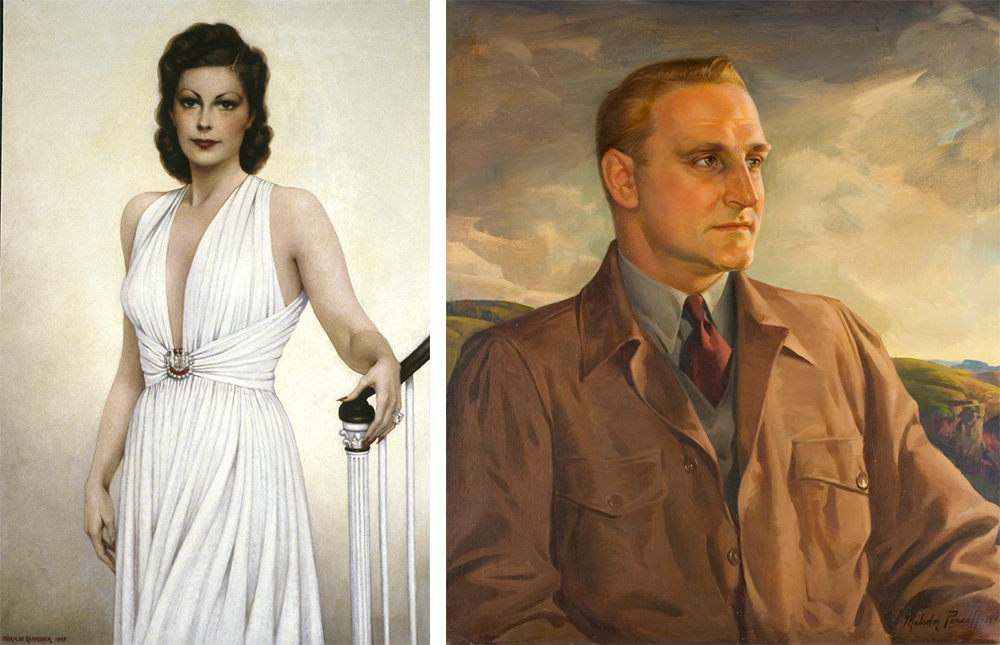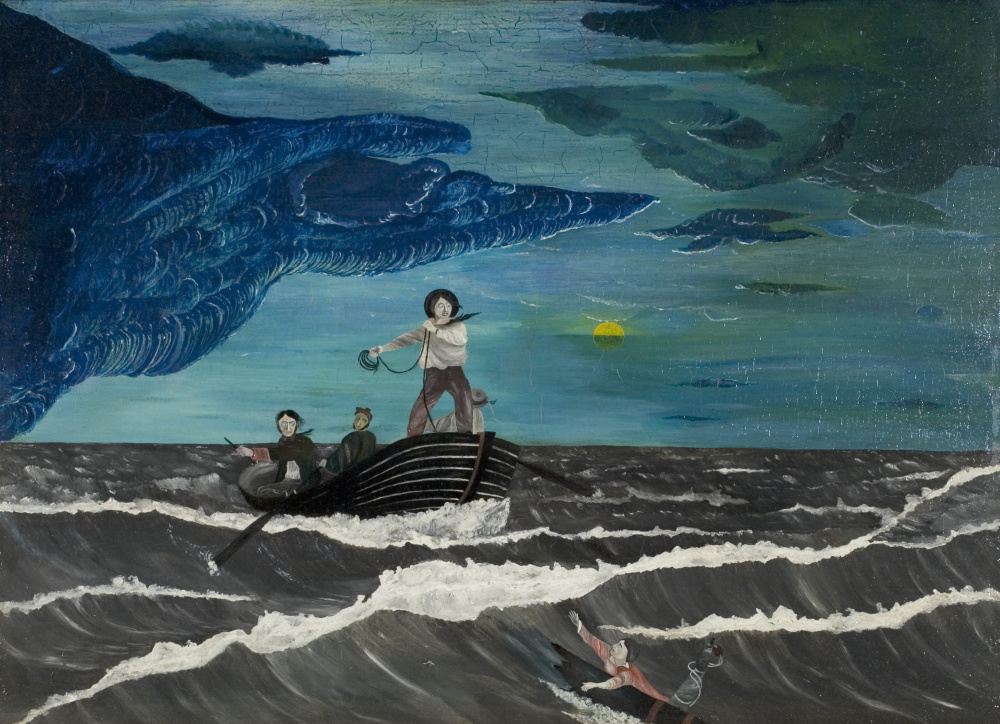- Open today, 10 am to 5 pm.
- Parking & Directions
- Free Admission
Collecting Runs in the Family: Walter P. Chrysler, Jr. and Bernice Chrysler Garbisch
–Corey Piper, PhD, Brock Curator of American Art

Unknown Artist, Landscape with Animals, ca. 1850, Oil on canvas, Gift of Edgar William and Bernice Chrysler Garbisch, 80.181.12
Collecting was an obsession that ran deep within the Chrysler family. While Walter P. Chrysler, Jr. was building the collection that would eventually come to the Chrysler Museum of Art, his sister Bernice Chrysler Garbisch and her husband Colonel Edgar William Garbisch formed one of the nation’s preeminent collections of American folk art. Their collection included a wide array of works, including Chinese porcelain and pieces by French Impressionists. However, their main focus was collecting American folk or vernacular art from the eighteenth and nineteenth centuries.
The couple lived most of their lives on Maryland’s Eastern Shore, where they amassed a collection that included more than 2,600 American folk paintings. Throughout their lives, they donated nearly the entirety of the collection to more than twenty museums throughout the United States, including the National Gallery of Art, the Metropolitan Museum of Art, and the Chrysler Museum, which received 162 works of art from their collection.

Left, Maria Kammerer, Portrait of Bernice Chrysler Garbisch, 1940, Oil on canvas, Gift of Edgar William Garbisch, Jr. and Gwynne Garbisch McDevitt, 81.19
Right, Malcolm Parcell, Portrait of Colonel Edgar William Garbisch, 1940, Oil on canvas, Gift of Edgar William Garbisch, Jr. and Gwynne Garbisch McDevitt, 81.20
Bernice was the elder sister of Walter. P. Chrysler, Jr. and, like her brother, began collecting at an early age. Her studies in Paris fueled her interest. When she married in 1930, she had already begun acquiring European porcelain and works by the Impressionists. Edgar William graduated from West Point, where he was a football standout. He served in the U.S. Army Corps of Engineers and later worked as an executive in the grocery business. The couple collected together on lavish trips to Europe, but their collection gained focus after 1941 when Bernice inherited their estate, Pokety on the Eastern Shore, from her father, Walter. P. Chrysler, Sr.
The Garbisches made their home at Pokety and set out to furnish the rooms with early American art and antiques. Their buying began in earnest in the 1940s and continued unabated into the next decade. In 1949, they bought 477 paintings in the style they preferred to call “American Naïve Paintings.” Unsurprisingly, they quickly found their walls overwhelmed with artwork, and they began placing their collection at museums. In 1954, they donated around 200 paintings to the National Gallery of Art in Washington. The couple made several gifts to the Chrysler beginning in 1974 and continuing through their bequest in 1981. Bernice and Edgar both passed away in 1979 after nearly 50 years of marriage and a shared love of collecting.

Joshua Johnson (American, active ca. 1796–1824), Mrs. Abraham White, Jr. and Daughter Rose, ca. 1808–09, Oil on canvas, Gift of Edgar William and Bernice Chrysler Garbisch, 74.6.12
The rich and varied artworks they donated to the Chrysler chart a distinct visual history of the early United States that thrived outside the nation’s formal institutions of fine art. Portraiture flourished in early America, and the Garbisch collection is particularly strong in examples of this genre. These works were often by itinerant artists or painters based outside major metropolitan centers like New York or Boston. Nevertheless, many of these painters like Ammi Phillips, Jacob Eichholtz, and Joshua Johnson enjoyed prolific and lucrative careers. While these artists’ style of portraiture is often characterized by directness and simplicity of forms, the term “folk art” usually does not fit comfortably as a means to categorize such artists. Many of these painters, even those whose identities are lost to us, received varying levels of formal training and engaged with sophisticated iconography and techniques in their representations of the sitters.

Unknown Artist, A Rescue after the Squall, ca. 1840, Oil on canvas, Gift of Edgar William and Bernice Chrysler Garbisch, 76.53.30
The paintings in the Garbisch collection include a wide array of subjects beyond portraiture. Landscape paintings, still lifes, and scenes of everyday life offer intriguing (and sometimes charming) insights into the social world of early America while also demonstrating the tremendous demand for art and images that persisted among a wide range of the nation’s populace. For a society that engaged in seafaring as a regular function of commerce and personal travel, paintings like A Rescue after the Squall, depicting a nighttime rescue operation following a shipwreck, directly and succinctly expresses the intensity and high-stakes of life at sea. While landscape painting, as practiced by Hudson River School artists like Albert Bierstadt or Worthington Whittredge, dominated formal art institutions in the United States during the mid-nineteenth century, many folk artists painted landscapes from a more personal and less mediated perspective. The unidentified artist who created Landscape with Animals populated the rocky and seemingly foreboding landscape with a sheltering couple and their small flock of animals. The humble cabin in the distance contributes to a sense of hope or constancy that suffuses the scene, though the precise sources of the artist’s symbolism remain elusive.
The Garbisches recognized a great value in preserving the art of the United States that proliferated outside of the country’s more formal artistic institutions and networks of patronage. For many, the straightforwardness of representation and directness of expression that characterize the work of many of these artists is the source of their primary charm. The artworks that form the Garbisch collection are united under broad and imperfect headings like folk art, naïve painting, or outsider art that are meant to indicate a shared visual language that was less constrained by formal academic concerns. In this regard, the Garbisches exercised great foresight in recognizing the unique contribution that American art of the folk tradition makes to shaping our understanding of the social and artistic history of the United States’ early decades. That they saw fit to share this vision so widely through donations to museums is a testament to their keen understanding of American art.
Their gift to the Chrysler resonates even more deeply thanks to the family connection rooted in the generosity of art. In 1980, Walter P. Chrysler, Jr. donated Thomas Cole’s The Angel Appearing to the Shepherds to the Chrysler in memory of Edgar William and Bernice Chrysler Garbisch, and in 1981, their children donated the pair of portraits of their parents painted in 1940, just a decade into their long union. Together, Edgar William and Bernice Chrysler Garbisch revived interest in American folk art traditions and elevated the genre’s status as an area worth preservation and serious study.

